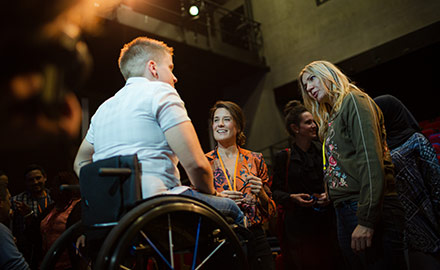
Diversity, Equity, and Inclusion (DEI) is an important priority in today's world - and there is good reason for it.
 Being fully inclusive and accepted is something we all strive for. Awareness around the complexity of this topic is still growing, however. Fundamentally it is about acknowledging that everybody has a right to fair and equal treatment, irrespective of age, gender, disability, sexual orientation, or any other characteristic, and putting measures in place that will enable everybody to participate equally.
Being fully inclusive and accepted is something we all strive for. Awareness around the complexity of this topic is still growing, however. Fundamentally it is about acknowledging that everybody has a right to fair and equal treatment, irrespective of age, gender, disability, sexual orientation, or any other characteristic, and putting measures in place that will enable everybody to participate equally.
This is particularly important for the event industry. When people come together for a mutual purpose, it is vital that any meeting or event is accessible to all, that everyone feels welcome, respected, and able to fully participate. There are lots of ways you can create a fully inclusive event environment; here are the top tips from our experts at CWT Meetings & Events.
Set up the right team:
Where possible, opt for a team that is as diverse as the event you are hoping to create. Doing so builds the foundation for a richer and more balanced event.
Ensure venue accessibility:
Ensure your venue is suitable for disabled attendees including, but not limited to, wheelchair-accessibility, hearing loops or sign language interpreters and allow service animals. The Americans with Disabilities Act (ADA) has a set of guidelines that you can use as a reference.
Book diverse speakers:
To create an event where everyone feels welcome and included, make sure the speakers reflect that sentiment. Feature people from different nationalities, genders, religious affiliations, and cultural backgrounds.
Create rich content:
Your content and topics should contribute to a richer and more balanced event. Make sure that your content resonates with all attendees, and encourage discussions and differing opinions.
Apply inclusive language:
Be gender-neutral where possible and avoid exclusive language that may not be relatable to everyone.
Outline agenda and logistics:
Build in sufficient time for attendees with disabilities and limited mobility to move between sessions or get refreshments. Also, make sure to avoid dates that coincide with key religious holidays.
Cater for all:
Along with the usual considerations for those with allergies or religious dietary requirements, you should also include vegan and ‘free from’ menu options. To help with planning, you can usually collect this information from participants ahead of time to share with the catering team.
Go hybrid:
Adding a virtual element is a great way to save on travel, accommodation and F&B costs and carbon emissions, but it also supports inclusivity. Those who find it difficult to travel or are not comfortable to do so in-person can still participate.
Ask for feedback:
Consider sending a post-event survey that asks about the inclusion and accessibility at the event and use the insights to continue improving.
Choosing to be fully inclusive is not only beneficial for attendees, but for businesses too. Creating a positive and welcoming environment by making people feel they belong means they can contribute to their full potential. This supports your desired goals and ultimately your event will be more successful.
Bringing you a new limitless era to meetings and events
To find out more, contact us today
